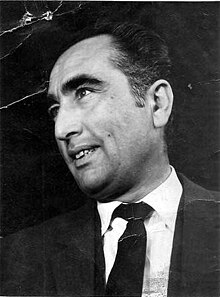| Revision as of 14:48, 30 December 2024 edit2407:d000:a:ab03:c8eb:47f:2303:5ac6 (talk) Tanolis aren't MughalsTags: Reverted Visual edit Mobile edit Mobile web edit← Previous edit | Revision as of 20:37, 31 December 2024 edit undoSutyarashi (talk | contribs)Extended confirmed users8,486 edits Reverted 1 edit by 2407:D000:A:AB03:C8EB:47F:2303:5AC6 (talk): Rv sockTags: Twinkle Undo Mobile edit Mobile web editNext edit → | ||
| Line 15: | Line 15: | ||
| ==Pakistan== | ==Pakistan== | ||
| ] | |||
| In Pakistan, Mughal people are mostly settled in the provinces of Azad Kashmir, ] and ].<ref name=Levin/> | In Pakistan, Mughal people are mostly settled in the provinces of Azad Kashmir, ] and ].<ref name=Levin/> | ||
Revision as of 20:37, 31 December 2024
Group of clans of North India and Pakistan For the people of Central Asia, see Moghol people. Ethnic group Mirza Aqil Hussain Barlas Mirza Aqil Hussain Barlas | |
| Regions with significant populations | |
|---|---|
| Languages | |
| Urdu, Punjabi, Bangla Persian (formerly) | |
| Religion | |
| Islam | |
| Related ethnic groups | |
| Pakistani people, Indian people and Bangladeshi people |
The Mughals (also spelled Moghul or Mogul) is a Muslim corporate group from modern-day North India, Pakistan and Bangladesh. They claim to have descended from the various Central Asian Mongolic, and Turkic peoples that had historically settled in the Mughal India and mixed with the native Indian population. The term Mughal (or Moghul in Persian) literally means Mongol.
Pakistan

In Pakistan, Mughal people are mostly settled in the provinces of Azad Kashmir, Punjab and Khyber Pakhtunkhwa.
India
In North India
The Mughals commonly use "Mirza" as their surname. They are also sometimes referred to as Chughtais or Chagatai Türks named after Chagatai Turkic language spoken by the Barlas and other Central Asian tribes. But one of the social groups that are claim to as the Ashraaf.
In Uttar Pradesh
The Sambhal, who claim Turkic descent, identify as a Biradari, literally translating to "brotherhood", which is the word used for a social unit based on kinship such as tribe or clan. The chief of the Biradari is the "Sardar", who is usually an elder man annually elected as the greatest man in the Biradari. Decisions on important matters are taken only after consulting the Biradari, and once taken binding on every member.
Gujarat
The community had traditionally served as soldiers in the armies of the various Indo-Muslim dynasties which ruled the Indian subcontinent. They were and still are a community of small to medium-sized farmers. A good many are also traders. Like other Gujarati Muslims, they have a caste association known as the Jamat, which acts both as a welfare organization and an instrument of social control. In North India, the term Mughal refers Gürkani or Timurids.
See also
- Khan Mughal
- Turco-Mongol tradition
- Changaizi
- Baig mughal
- Taimoori Mughal
- Tatar
- HAZARA Mughal
- Sardar Mughal
- Bib Mughal
- Chughtayi
- Mirza
- Maingal
- Maldiyal
- Qiyat
- MONGOL
References
- ^ Levin, S. F. (2006). "Mughal". In Malik, Hafeez; Gankovsky, Yuri V. (eds.). The Encyclopedia of Pakistan. Oxford University Press. ISBN 978-0-19-597735-6.
- Сабитов Ж. М., Баймуханов Н. Б. (2015). "Y-STR гаплотипы узбеков, уйгуров, таджиков, пуштунов, хазарейцев, моголов из базы данных Family Tree DNA". The Russian Journal of Genetic Genealogy (in Russian) (2): 22–23.
- Liz Wyse and Caroline Lucas (1997). Atlas Of World History. Scotland: Geddes & Grosset.
- Collins Compact Dictionary. Glasgow: HarperCollins. 2002. ISBN 0-00-710984-9.
- Rajendra K. Sharma (2004). Indian Society, Institutions and Change. Atlantic Publishers & Dist. p. 71. ISBN 978-81-7156-665-5.
- Muslim Caste in Uttar Pradesh (A Study of Culture Contact), Ghaus Ansari, Lucknow, 1960
- Shenila Khoja-Moolji (2018). Forging the Ideal Educated Girl:The Production of Desirable Subjects in Muslim South Asia. University of California Press. ISBN 978-0-520-97053-3.
- Khan Amanat (1938). Agriculture and Live Stock In India Vol-viii. The Imperial Council Agriculture Research. p. 485.
- People of India Gujarat Volume XXI Part Three edited by R.B Lal, P.B.S.V Padmanabham, G Krishnan & M Azeez Mohideen pages 1394-1399
| Mongolic peoples | |||||||||||
|---|---|---|---|---|---|---|---|---|---|---|---|
| History | |||||||||||
| Proto-Mongols | |||||||||||
| Medieval tribes | |||||||||||
| Ethnic groups |
| ||||||||||
| See also: Donghu and Xianbei · Turco-Mongol · Modern ethnic groups Mongolized ethnic groups.Ethnic groups of Mongolian origin or with a large Mongolian ethnic component. | |||||||||||
| Turco-Mongol | |
|---|---|
| States | |
| Related ethnic groups and clans | |
| Culture | |
| Origin is controversial. | |